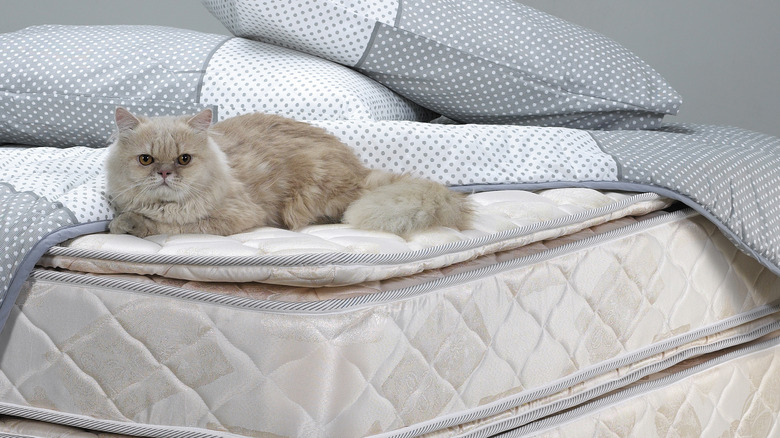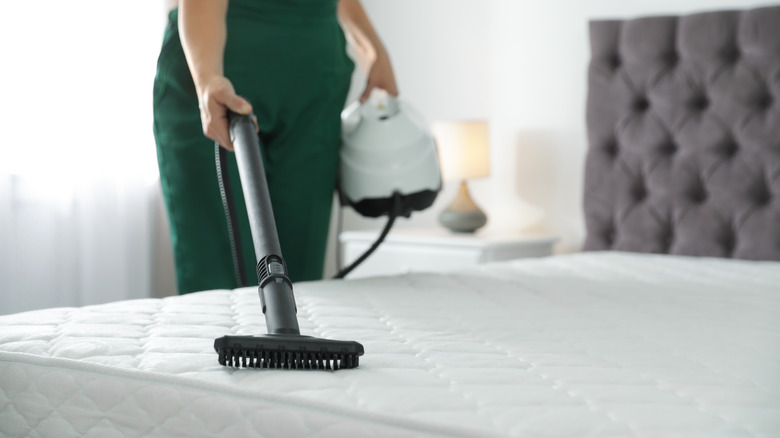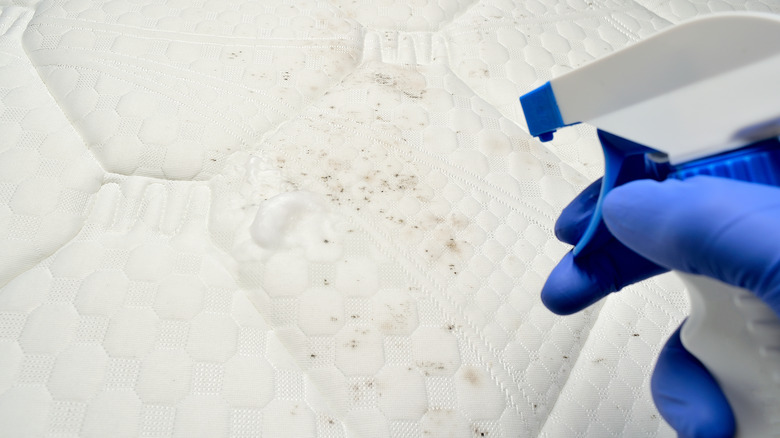The Easiest Solution To Get Cat Pee Out Of Your Mattress Is In Your Pantry
How do you clean cat pee out of your mattress? You're already having a bad day when you're looking for information on a topic like this.
Cat pee has a strong scent, and it can penetrate deep into the mattress's layers, making it hard to simply wipe away. You may have tried a cabinet full of other remedies and proven solutions only to find that you just cannot get rid of it. And the longer it remains, the more problematic it will be for you. Some cats will continue to return to the location where they smell their scent and continue urinating in that space. That means that until you fully and completely clean the cat pee smell and remove all traces of it, those felines could continue to make your bed their litter box.
The easiest solution to clean cat pee out of your mattress (as well as other surfaces) is to use baking soda. This, along with a bit of white vinegar and a few tried-and-true steps, makes it possible to remove not just the discoloration and pee itself but also the lingering odor that often accompanies it.
It's a good idea to mention this to your vet, too, since some cats will pee on a mattress to get their owner's attention. They may also have a urinary tract infection or may be struggling healthwise in another way.
What you need to get cat pee smell out of your mattress
Before doing anything else, you'll need to assemble some basic pantry items to help you clean away the cat pee and smell. You'll need baking soda (make sure it's not too old and within the use-by date). You'll also benefit from having white vinegar and an enzyme cleaner available to you.
The first step is to absorb as much of the cat pee from the surface as possible. To help to deactivate the cat pee faster, pour some baking soda directly onto the wet portion of the mattress. By applying it right to the surface, the baking soda will begin pulling up the moisture from the surface, trapping it in the material. You'll notice the powder getting darker as it continues to pull the moisture out of the bed.
You'll then need to use a vacuum to pull up the baking soda. Don't allow it to dry out fully. Once you notice that the baking soda is saturated, use a vacuum to pull up all of the powder. Then, repeat this process, allowing the baking soda to remain for a few minutes to continue to soak up more of the cat pee. Do this several times until the baking soda no longer changes color, which means it's not absorbing anything into it any longer. This step is critical because the baking soda works to trap the moisture and pulls it out from even deeper within the mattress.
Minimizing the risk of the cat peeing on the mattress again
This method works well to remove much of the actual cat pee, but the odor may linger on an ongoing basis. This is when the use of an enzyme cleaner is critical. Because cat pee is more concentrated than urine from people, it has a much stronger scent to it that can linger. The enzyme cleaner is specifically designed to tackle those remaining odors by getting rid of the ammonia and other elements present in cat pee. Most products will provide very specific directions for using them, and you should follow the baking soda method as a first step. Then, follow up with an enzyme cleaner (even if you don't notice any odor). These products are typically applied to the area, allowed to sit, and then cleaned away or allowed to dry.
Don't forget to treat your bedding as well. Toss all bedding, even any pillows or nearby blankets that could have been peed on, into the wash. Use a liquid laundry detergent to clean them. Add a cup of white vinegar to the laundry cycle to help with removing the scent. You may need to wash the sheets at least twice to get rid of those smells.
Clean up all pet stains as quickly as possible to minimize the cat's desire to re-soil those areas. It's not always easy to do, but it can help to protect your mattress.


